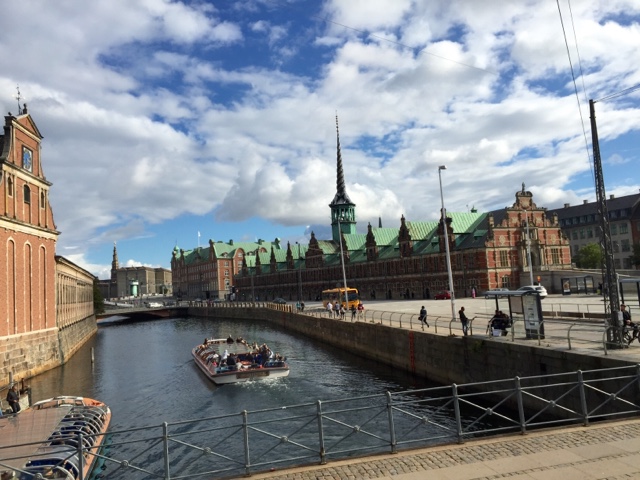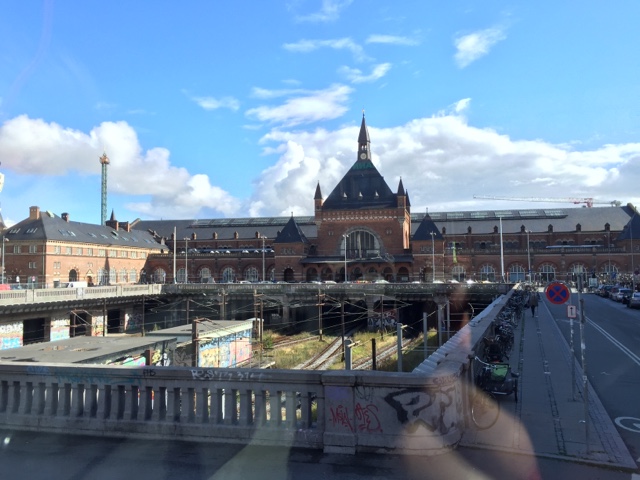The rains had cleared and we decided the morning would be perfect for our boat tour.
On our walk to the boat launch, we passed Nyhavn and a lovely woman took the best photo of the whole trip - with only one take!
Being early, we snagged two front outdoor seats on the next boat leaving the dock.
If you do nothing else in Copenhagen, you must take a canal tour. It is so delightful to see the architecture from the sea, as generations before have first seen the city.
The boat pulls out of a short canal and into Inderhavn, where we could see the strip near our hotel, and then our hotel with construction in front.
One of the buildings we passed was Gammel Dok, a former warehouse built in 1882. Today it houses the Danish Architecture Center and the 2-Michelin star restaurant Noma, which takes months to get in.
Then we pulled into Nyhavn. Our boat guide, who spoke fluent English, Spanish and Danish interchangeably, warned us to stay in our seats because the boats pass closely beneath the bridges. Indeed they do! High water might be a problem.
More lovely views of Nyhavn, this time from the water. The canal also serves as a "heritage harbor" for many historic wooden ships. Someone seems to be living on this one.
One of the highlights from the water is the ultra modern Opera House, completed in 2005 for about $500 million. It has a main stage with 5 other stages and 1,000 rooms.
Across from it is Amalienburg Palace, the royal residence since 1794. The family actually lives in the building to the right and a flag is on top (like now) when a royal is in residence.
Then we entered the Christianshavn Canal, which is lined with a number of centuries-old houses that have been spared the fires of the city. Along this canal, we had a great view of the spiral tower of Our Saviour's Church, completed in 1752, which has a walkway to the top. Heard the stairs get very narrow toward the top. Not for us.
Coming out of the canal, we saw the "Black Diamond," Copenhagen's library, named for the black granite exterior that sparkles in the sunlight.
Following the boat tour, we decided to walk around the city center. We found our way to Stroget, Europe's first and longest pedestrian street. When it was inaugurated in 1962, shopkeepers were skeptical, but since then it has caught on throughout the world. More have even been added in this city. We stopped by the graceful Stork Fountain built in 1894 on Amagertov, which has been a popular meeting place since the Middle Ages. Another main pedestrian street, Kobmagergade, branches off here. I liked the very old building tucked in between some newer structures to the right behind me.
We walked down a street to the Round Tower, which was erected as an observatory in 1642 by King Christian IV. There are no stairs, only a spiral ramp for transporting astronomical equipment. You can still go up for great views of the city at about 137 feet high.
On the pedestrian streets, we saw a lot of women pushing baby carriages. We later learned that Denmark has a negative birth rate and is encouraging people to have children. Thought their choice of traditional baby carriages was interesting.
We ducked down some side streets looking for lunch. Along the way we saw numerous "bicycle parking lots." I don't know how people find their own. Denmark encourages people to ride bikes and places a 180% tax on imported cars to discourage driving. The city plans to be carbon neutral by 2025. We also saw a lot of the 3-wheelers with the cart in front to transport everything from children to groceries.
Back to lunch. Our first Rick Steve's recommendation Schonnemann ("best lunch in town") was booked solid so we made our way to his second, Cafe Halvvejen, on a side street in a basement. Another tiny, tiny place. We got there just in time to snag a table - place could only hold 20 and there were people behind us. Here we got to taste the best "smorrebrod" - open-faced Danish sandwiches on a heavy rye bread. The owner said they are different every day. We had fried fish cakes, egg and shrimp, and bacon and potatoes, with accompanying sauces. They were amazing. We passed on the traditional "snaps" that usually accompanies them.
Then we saw our red bus and hopped back on to go back to our hotel. On the way, we stopped at the Little Mermaid statue along the promenade at Langelinie to get a photo. There were swarms of Asian tourists all around her, trying to take multiple poses with her. We were quite patient, but surprised at the spectacle. Ed managed to snap a quick one of me before the next bus of Asians unloaded. The statue was erected in 1913, based on the character of the fairy-tale of the same name, written in 1836 by Hans Christian Andersen. (She has been beheaded twice but fortunately the original molds have survived and she is regenerated.) It is the most photographed symbol of the city.
From there we were able to walk back to our hotel.
Tonight we had dinner at Puk Restaurant, which was recommended by some people from our cruise. Fortunately, we had reservations. Again, a very small place (maybe seats 40) in a basement. A group of 12 American business people had commandeered our little table so they could spread out. The proprietress admonished them and they gave it up, so we had a perfect little seat on benches in a corner. I was impressed she would do that but she said "but you have reservations!" It was the only table left. The food was impressive and Ed buried his head in his meat and potatoes.































































